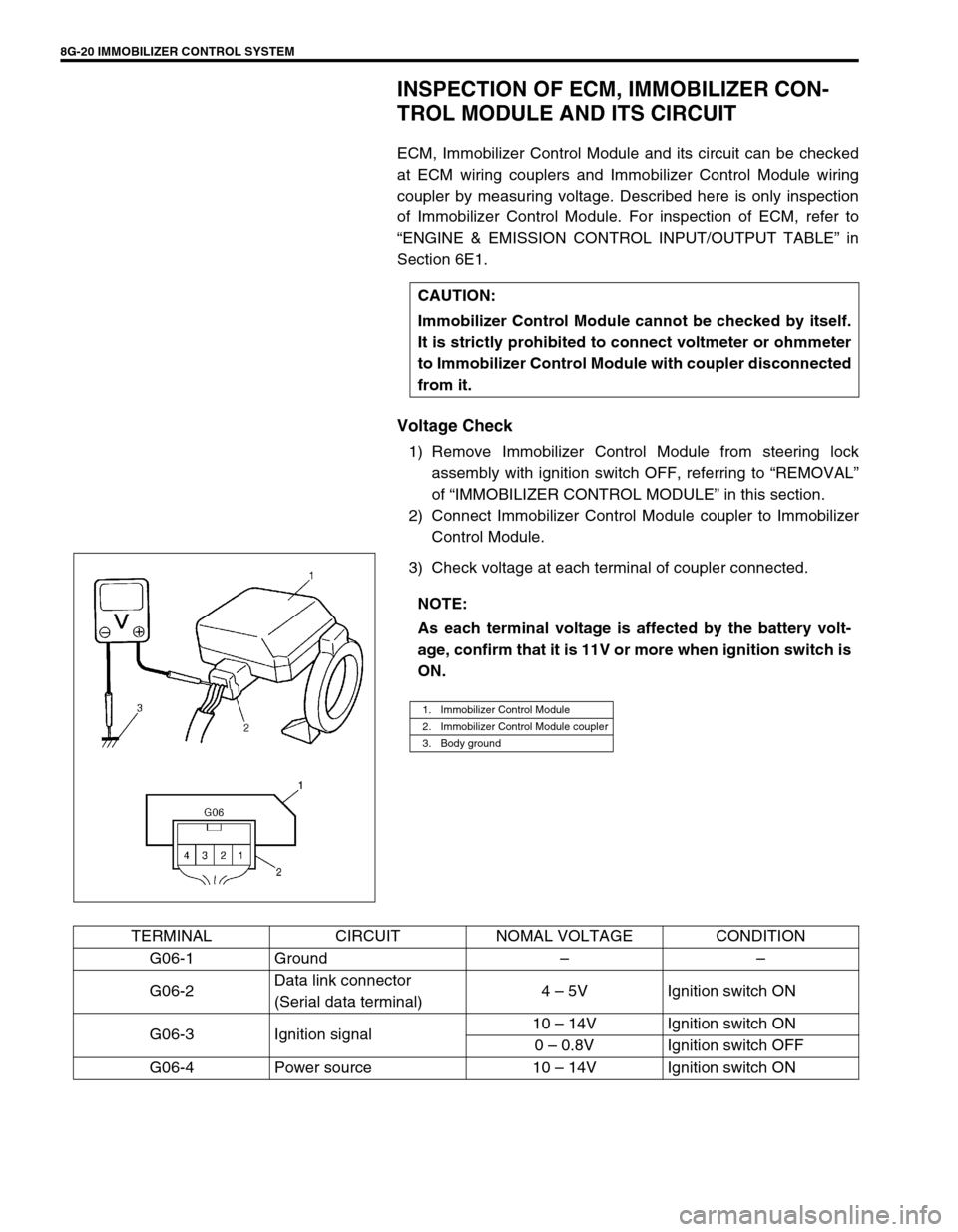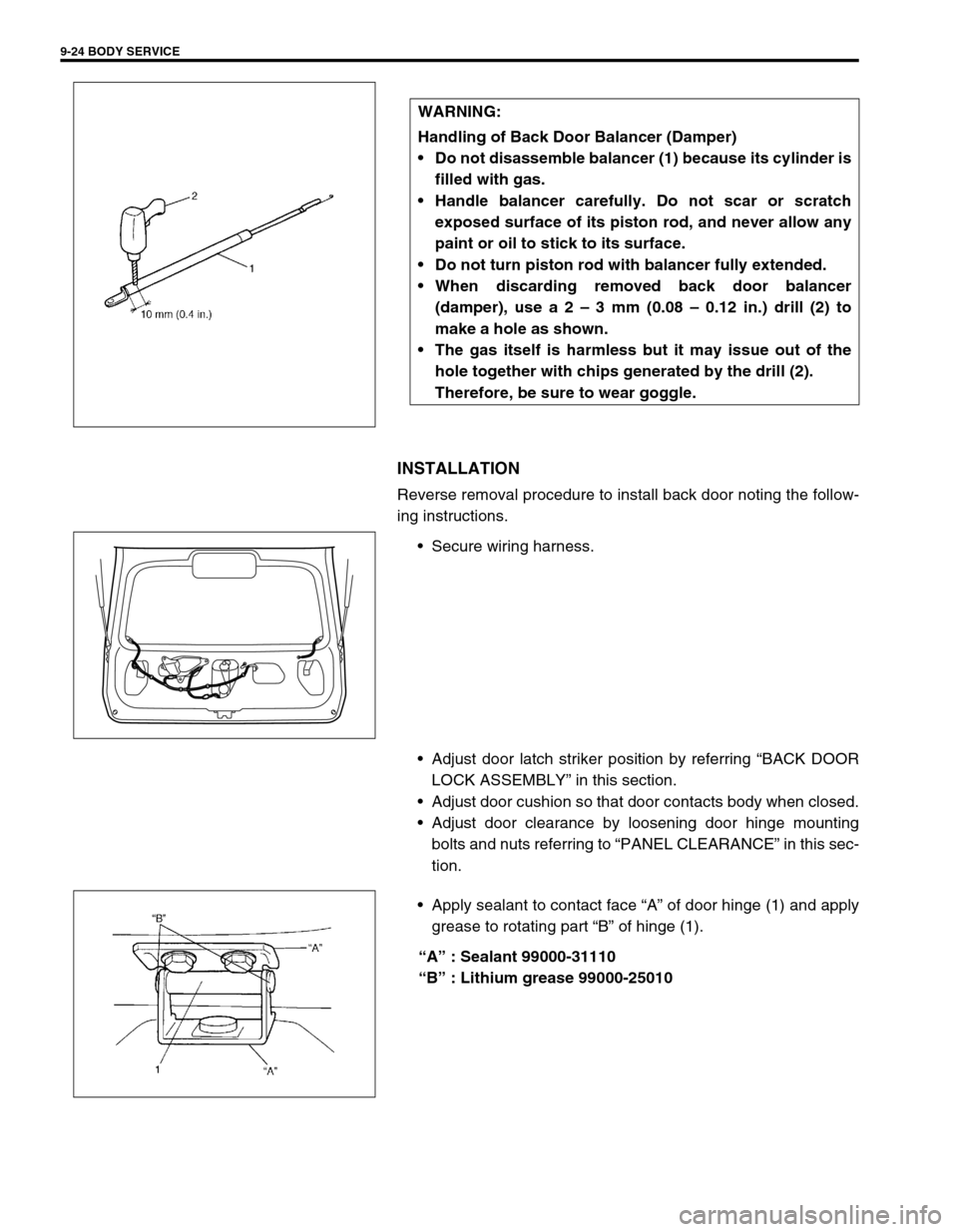2000 SUZUKI SWIFT wiring
[x] Cancel search: wiringPage 288 of 447

8G-10 IMMOBILIZER CONTROL SYSTEM
TABLE A - IMMOBILIZER INDICATOR LAMP CHECK (IMMOBILIZER INDICA-
TOR LAMP DOES NOT LIGHT AT IGNITION SWITCH ON)
WIRING DIAGRAM
INSPECTION
1. Main fuse 2. Main relay 3. ECM 4. Immobilizer indicator lamp
BRN/WHT
BLK/RED
BLK/WHT
PNKBLK
BLK/ORG
BLK/ORG
BLK/YEL
C42-2
C42-1
C42-3 C41-10
C41-5/6
G02-6
G02-12
4
1
2
3
Step Action Yes No
1 1) Turn ignition switch ON.
Do other indicator/warning lights in combination
meter come ON?Go to Step 2.“IG” fuse blown, main fuse
blown, ignition switch mal-
function, “BLK/WHT” circuit
between “IG” fuse and com-
bination meter or poor cou-
pler connection at
combination meter.
2 1) Turn ignition switch OFF and disconnect
connectors from ECM.
2) Check for proper connection to ECM at ter-
minal G02-12.
3) If OK, then using service wire, ground termi-
nal G02-12 in connector disconnected.
Does immobilizer indicator lamp turn on at igni-
tion switch ON?Substitute a known-
good ECM and
recheck.Bulb burned out or “PNK”
wire circuit open.
Page 289 of 447

IMMOBILIZER CONTROL SYSTEM 8G-11
TABLE B - IMMOBILIZER INDICATOR LAMP CHECK (IMMOBILIZER INDICA-
TOR LAMP REMAINS ON AFTER ENGINE STARTS)
WIRING DIAGRAM
INSPECTION
1. Main fuse 2. Main relay 3. ECM 4. Immobilizer indicator lamp
BRN/WHT
BLK/RED
BLK/WHT
PNKBLK
BLK/ORG
BLK/ORG
BLK/YEL
C42-2
C42-1
C42-3 C41-10
C41-5/6
G02-6
G02-12
4
1
2
3
Step Action Yes No
1 1) With ignition switch OFF, disconnect cou-
plers from ECM.
Does immobilizer indicator lamp turn ON at
ignition switch ON?“PNK” wire shorted to
ground circuit.Substitute a known-good
ECM and recheck.
Page 290 of 447

8G-12 IMMOBILIZER CONTROL SYSTEM
TABLE C - DTC IS NOT OUTPUT FROM IMMOBILIZER CONTROL MODULE
WIRING DIAGRAM
INSPECTION
1. To ECM 2. Immobilizer control module 3. To #9-pin in DLC
BLK/RED
BLK/WHTBLK/WHT
BLK
2
1
3
YEL
BLK/YEL
G06-4
G06-3
G06-1G06-2
Step Action Yes No
1 Check voltage between G06-4 terminal
and body ground with ignition switch
turned ON. See Fig 1.
Is it 10 – 14 V?Go to Step 2.“BLK/RED” wire
open or short to
ground.
2 1) Disconnect coupler (1) at immobilizer
control module.
Is there continuity between coupler termi-
nal G06-1 and body ground? See Fig 2.Poor G06-4 or G06-1 connection
Poor #9-pin connection in DLC
Serial data line “YEL” open or short
to ground
If connections and line are OK, substi-
tute a known-good Immobilizer Con-
trol Module and recheck.
See NOTE below.“BLK” wire open.
NOTE:
After replacing with a known-good Immobilizer Control Module, register ECM/Immobilizer Control
Module code in ECM and Transponder code and ECM/Immobilizer Control Module code in Immobilizer
Control Module by performing procedure described in “PROCEDURE AFTER IMMOBILIZER CON-
TROL MODULE REPLACEMENT” in this section.
Page 296 of 447

8G-18 IMMOBILIZER CONTROL SYSTEM
DTC23 NO ECM/IMMOBILIZER CONTROL MODULE CODE TRANSMITTED
FROM ECM OR DLC CIRCUIT OPENED/SHORTED
DTC P1621 NO ECM/IMMOBILIZER CONTROL MODULE CODE TRANSMITTED
FROM IMMOBILIZER CONTROL MODULE OR DLC CIRCUIT OPENED/
SHORTED
DESCRIPTION
When the ignition switch is ON, Immobilizer Control Module requests ECM and ECM requests Immobilizer Con-
trol Module to transmit ECM/Immobilizer Control Module code. If ECM/Immobilizer Control Module code is not
transmitted from ECM or Immobilizer Control Module, Immobilizer Control Module sets DTC23 and ECM sets
DTC P1621.
INSPECTION
1. Immobilizer Control Module 2. ECM 3. To #9-pin in DLC
YEL G06-2G02-7YEL
YEL
1
32
Step Action Yes No
1 Check voltage between Immobilizer Con-
trol Module (1) coupler terminal G06-2
and body ground with ignition switch
turned ON.
Is it 4 – 5V?Go to Step 2.“YEL” wire short.
2 1) Disconnect ECM coupler with ignition
switch turned OFF.
2) Is there continuity between Immobi-
lizer Control Module coupler (1) termi-
nal G06-2 and serial data link terminal
(G02-7) of ECM coupler? (For posi-
tions of Data link connector terminal
of ECM coupler, refer to “WIRING
CIRCUIT” in this section.)Poor G06-2 terminal connection
(Immobilizer Control Module) or Poor
Data link connector terminal connec-
tion (ECM).
If connections are OK, substitute a
known-good ECM or Immobilizer Con-
trol Module and recheck.
See NOTE below.“YEL” wire between
Immobilizer Control
Module and ECM
open.
Page 298 of 447

8G-20 IMMOBILIZER CONTROL SYSTEM
INSPECTION OF ECM, IMMOBILIZER CON-
TROL MODULE AND ITS CIRCUIT
ECM, Immobilizer Control Module and its circuit can be checked
at ECM wiring couplers and Immobilizer Control Module wiring
coupler by measuring voltage. Described here is only inspection
of Immobilizer Control Module. For inspection of ECM, refer to
“ENGINE & EMISSION CONTROL INPUT/OUTPUT TABLE” in
Section 6E1.
Voltage Check
1) Remove Immobilizer Control Module from steering lock
assembly with ignition switch OFF, referring to “REMOVAL”
of “IMMOBILIZER CONTROL MODULE” in this section.
2) Connect Immobilizer Control Module coupler to Immobilizer
Control Module.
3) Check voltage at each terminal of coupler connected.CAUTION:
Immobilizer Control Module cannot be checked by itself.
It is strictly prohibited to connect voltmeter or ohmmeter
to Immobilizer Control Module with coupler disconnected
from it.
NOTE:
As each terminal voltage is affected by the battery volt-
age, confirm that it is 11V or more when ignition switch is
ON.
1. Immobilizer Control Module
2. Immobilizer Control Module coupler
3. Body ground
TERMINAL CIRCUIT NOMAL VOLTAGE CONDITION
G06-1 Ground––
G06-2Data link connector
(Serial data terminal)4 – 5V Ignition switch ON
G06-3 Ignition signal10 – 14V Ignition switch ON
0 – 0.8V Ignition switch OFF
G06-4 Power source 10 – 14V Ignition switch ON
Page 305 of 447

BODY SERVICE 9-1
6F1
6F2
6G
6H
6K
7A
7A1
7B1
7C1
7D
7E
7F
8A
8B
8C
8D
8E
9
10
10A
10B
SECTION 9
BODY SERVICE
CONTENTS
GLASS, WINDOWS AND MIRRORS ................. 9-2
FRONT DOOR GLASS ................................... 9-2
FRONT DOOR WINDOW REGULATOR ........ 9-6
DOOR MIRROR .......................................... 9-7
REAR DOOR GLASS (IF EQUIPPED) ....... 9-8
REAR DOOR WINDOW REGULATOR ........ 9-11
WINDOW SHIELD ........................................ 9-12
QUARTER WINDOW .................................... 9-17
BACK DOOR GLASS .................................... 9-18
BODY STRUCTURE......................................... 9-19
FRONT DOOR ASSEMBLY .......................... 9-19
REAR DOOR ASSEMBLY ............................ 9-22
BACK DOOR ASSEMBLY ............................ 9-23
HOOD ........................................................... 9-25
FRONT FENDER .......................................... 9-26
FRONT BUMPER AND REAR BUMPER...... 9-27
ROOF RAIL (IF EQUIPPED) ......................... 9-28
BODY DIMENSIONS .................................... 9-29
ENGINE ROOM ........................................ 9-29
BACK DOOR ............................................. 9-30
SIDE BODY ............................................... 9-31UNDER BODY .......................................... 9-34
PANEL CLEARANCE ................................... 9-36
INSTRUMENTATION AND DRIVER
INFORMATION................................................. 9-38
INSTRUMENT PANEL .................................. 9-38
SEATS .............................................................. 9-40
FRONT SEAT ............................................... 9-40
REAR SEAT.................................................. 9-41
SECURITY AND LOCKS ................................. 9-42
FRONT DOOR LOCK ASSEMBLY............... 9-42
REAR DOOR LOCK ASSEMBLY (IF
EQUIPPED) .................................................. 9-44
BACK DOOR LOCK ASSEMBLY ................. 9-45
KEY CODING ............................................... 9-46
KEY USAGE AND IDENTIFICATION ....... 9-46
IGNITION SWITCH LOCK CYLINDER ..... 9-47
EXTERIOR AND INTERIOR TRIM ................... 9-47
FLOOR CARPET .......................................... 9-47
HEAD LINING ............................................... 9-48
PAINT AND COATINGS .................................. 9-50 WARNING:
For vehicles equipped with Supplemental Restraint (Air Bag) System:
Service on and around the air bag system components or wiring must be performed only by an
authorized SUZUKI dealer. Refer to “Air Bag System Components and Wiring Location View” under
“General Description” in air bag system section in order to confirm whether you are performing ser-
vice on or near the air bag system components or wiring. Please observe all WARNINGS and “Ser-
vice Precautions” under “On-Vehicle Service” in air bag system section before performing service
on or around the air bag system components or wiring. Failure to follow WARNINGS could result in
unintentional activation of the system or could render the system inoperative. Either of these two
conditions may result in severe injury.
Technical service work must be started at least 90 seconds after the ignition switch is turned to the
“LOCK” position and the negative cable is disconnected from the battery. Otherwise, the system
may be activated by reserve energy in the Sensing and Diagnostic Module (SDM).
When body servicing, if shock may be applied to air bag system component parts, remove those
parts beforehand. (Refer to Section 10B.)
NOTE:
Fasteners are important attaching parts in that they could affect the performance of vital components
and systems, and / or could result in major repair expense. They must be replaced with one of the
same part number of with an equivalent part if replacement becomes necessary.
Do not use a replacement part of lesser quality or substitute a design. Torque values must be used as
specified during reassembly to assure proper retention of these parts.
Page 328 of 447

9-24 BODY SERVICE
INSTALLATION
Reverse removal procedure to install back door noting the follow-
ing instructions.
Secure wiring harness.
Adjust door latch striker position by referring “BACK DOOR
LOCK ASSEMBLY” in this section.
Adjust door cushion so that door contacts body when closed.
Adjust door clearance by loosening door hinge mounting
bolts and nuts referring to “PANEL CLEARANCE” in this sec-
tion.
Apply sealant to contact face “A” of door hinge (1) and apply
grease to rotating part “B” of hinge (1).
“A” : Sealant 99000-31110
“B” : Lithium grease 99000-25010 WARNING:
Handling of Back Door Balancer (Damper)
Do not disassemble balancer (1) because its cylinder is
filled with gas.
Handle balancer carefully. Do not scar or scratch
exposed surface of its piston rod, and never allow any
paint or oil to stick to its surface.
Do not turn piston rod with balancer fully extended.
When discarding removed back door balancer
(damper), use a 2 – 3 mm (0.08 – 0.12 in.) drill (2) to
make a hole as shown.
The gas itself is harmless but it may issue out of the
hole together with chips generated by the drill (2).
Therefore, be sure to wear goggle.
Page 343 of 447

BODY SERVICE 9-39
10) Remove instrument panel mounting bolts (2).
11) Remove instrument panel (1) with steering support member
and instrument panel harness.
INSTALLATION
Reverse removal procedure to install instrument panel noting the
following instructions.
When installing each part, be careful not to catch any cable
or wiring harness.
Tighten instrument panel mounting bolts (1) to specified
torque
Tightening torque
Instrument panel mounting bolts (a) :
23 N·m (2.3 kg-m, 17.0 lb-ft)
When installing steering column assembly, refer to “STEER-
ING COLUMN ASSEMBLY” in Section 3C.
Adjust control cables. Refer to “HEATER CONTROL
ASSEMBLY” in Section 1A.
Enable air bag system if equipped. Refer to “ENABLING AIR
BAG SYSTEM” in Section 10B.
2
2
22 2
1
1, (a)1, (a)